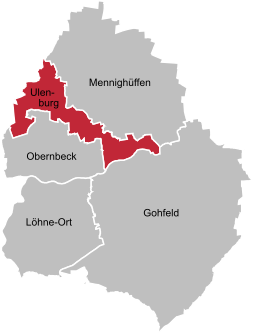Ulenburg
|
Ulenburg
City of wages
Coordinates: 52 ° 13 ′ 30 ″ N , 8 ° 41 ′ 11 ″ E
|
|
|---|---|
| Height : | 61 m above sea level NN |
| Area : | 5.2 km² |
| Residents : | 485 (Dec. 31, 2003) |
| Population density : | 93 inhabitants / km² |
| Incorporation : | 1st January 1969 |
| Postal code : | 32584 |
| Area code : | 05732 |
|
Location of Ulenburg in Löhne
|
|
Ulenburg is the smallest district of the city of Löhne in northeast North Rhine-Westphalia . Until it was founded in 1969, the place formed its own community . It was named after the local moated castle Ulenburg .
location
The district extends as a narrow strip of territory from the northwest of the urban area on both sides of the Mühlenbach to its confluence with the Werre in the northern center of Löhne. Neighboring districts are Mennighüffen in the north and northeast, Gohfeld and Löhne-Bahnhof in the southeast and Obernbeck in the southwest. Otherwise, Kirchlengern - Häver connects to the west . In general, Ulenburg is perceived as belonging to Mennighüffen, which can be attributed to the close historical and settlement-related connection.
Ulenburg Castle, Beck House, Schockemühle Estate
The former municipality of Ulenburg goes back to two estate districts around the former manor Ulenburg , Beck (pronounced: Beek ) and Schockemühle. The Schockemühle estate no longer exists, Haus Beck is privately owned and the location of an agricultural business. The Ulenburg Castle is a moated castle in the style of the Weser Renaissance , for which most of the bay in the southeast part of the upper floor and the south gable are characteristic.
Until 2008, the Wittekindshof Diaconal Foundation ran a facility in the castle to care for people with intellectual disabilities . Since then, the Ulenburg des Wittekindshof has consisted of three residential buildings near the castle.
On February 1, 2015, the property became the property of the Society of Yazidi Academics. The society is researching the history of the Yazidis in the historical buildings and wants to make Ulenburg an international meeting place for Yazidi culture.
history
A forerunner is assumed to be a Meierhof (called Ulenhof), which has been owned by a branch of the von Quernheim family since the late Middle Ages ; a second branch of the family sat at Haus Beck.
In 1469 Bernhard VII zur Lippe conquered the court and from then on the Quernheimers were feudal men of the Counts of Lippe . The Minden bishop did not agree with this situation. He did not want to grant Ulenburg any special privileges because he was of the opinion that Ulenburg, as a former Meierhof, had to comply with the general land law of the Hausberge office and thus could not exercise sovereign sovereignty .
Hilmar von Quernheim expanded the farm into a moated castle between 1568 and 1570. It is the only surviving structure of its kind in the Herford district in the Weser Renaissance style . After his death in 1581, the bishop decided to take the Ulenburg by force. Only 12 years later did the Counts of Lippe get the property back after many lawsuits and negotiations. However, the unrest continued.
In 1613 Philipp Eberhard von Wrede acquired the castle. Almost a hundred years later, in 1711, Ulenburg was sold to the von Ledebur family . In 1745 the two estates of Ulenburg and Beck were united under the new owner Werner Heinrich Christoph von Wulfen , Cathedral Chapter of Magdeburg . After his death, the heirs could not hold the property and went bankrupt .
The new owner was Baron von Mönster, who in 1786 acquired the Ulenburg, Beck and Schockemühle estates. He found no happiness in Ulenburg, and his wife Louise Friederike Wilhelmine died of smallpox just a year later . An obelisk , which Baron von Mönster zu Beck had erected in memory of his wife, stands not far from the castle.
The upper part of the obelisk bears the slogan: "Few were more beautiful. Better none".
In 1791 von Mönster sold the goods to Franz Christian von Borries zu Eckendorf . From 1846 the Russian Prince Handjery owned the Ulenburg, but sold the property back to the von Borries family in 1865 . In 1927, the Wittekindshof sanatorium finally acquired the castle.
On January 1, 1929, the Ulenburg and Beck manor districts were merged to form the new municipality of Ulenburg. As a result of the communal reorganization , the municipality of Ulenburg is absorbed into the newly founded town of Löhne on January 1st, 1969.
schools
• Municipal high school wages
Web links
- Material on Ulenburg Castle in the Duncker Collection of the Central and State Library Berlin (PDF; 211 kB)
Individual evidence
- ↑ Herford Weekly Gazette, March 25, 2008
- ^ Diakonische Stiftung Wittekindshof
- ↑ Birgit Meineke, Die Ortsnames des Kreises Herford, Verlag für Regionalgeschichte Bielefeld, 2011, ISBN 978-3-89534-924-9 , p. 277ff.
- ↑ Stephanie Reekers: The regional development of the districts and communities of Westphalia 1817-1967 . Aschendorff, Münster Westfalen 1977, ISBN 3-402-05875-8 , p. 287 .
- ↑ Martin Bünermann: The communities of the first reorganization program in North Rhine-Westphalia . Deutscher Gemeindeverlag, Cologne 1970, p. 75 .





